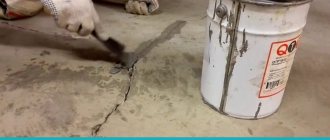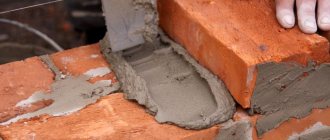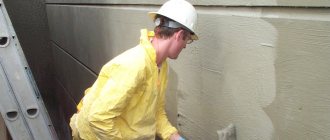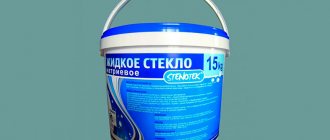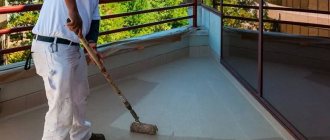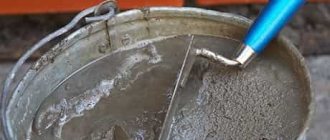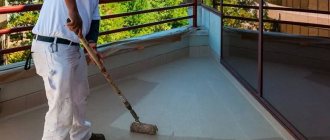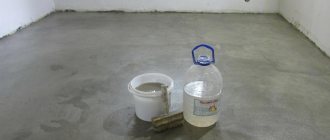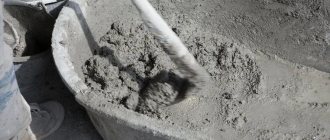The basic characteristic of concrete and cement-containing mortars is the compressive strength of the finished products. The process of setting and strengthening of the poured mortar is tied to the hydration of the cement. The minerals included in its composition react with water and atmospheric carbon dioxide, which leads to the creation of a strong crystalline structure, which, in turn, binds the filler: sand, gravel, slag, crushed stone, expanded clay.... In this article we will touch on the main additives in concrete and cement mortar, which modify their properties and which you can make with your own hands in the living conditions of an apartment or cottage.
DIY cement mortar and concrete, what it is and why - introductory
In fact, this is the simplest version of concrete: a mixture of cement mortar with coarse sand. It is mainly used as substrates for foundations or as a filler for metal forms (piles). Very little water is required for the solution - only for convenient stirring and hydration of the cement. It is possible to mix the mixture directly in the pouring mold or formwork.
To obtain stronger cement, it is necessary to add filler. It is curious that if the filler is porous materials (for example, expanded clay, slag, perlite, ...) - the concrete receives improved thermal insulation properties. Usually crushed stone with a fraction from 2-3 mm to 30-35 mm is used. Important!: crushed stone, like any other filler, must be clean! It is also recommended to use aggregates of different sizes with non-smooth surfaces, i.e. extracted by crushing rocks.
In the recipes below we will assume that 1 bag of cement is 50 kg. unless explicitly stated otherwise.
So, how to prepare concrete yourself:
- Prepare the mold or formwork.
- We choose aggregate with different sizes, for example, mixed large gravel or crushed stone with medium. Because at home, there is usually no equipment for high-quality compaction of concrete - it is the different size of the stone that will ensure a tight fit of the aggregate elements to each other, which does not allow the formation of large voids.
- Mix sand and cement in a trough, bucket or concrete mixer.
- We fill in water, which should be as clean as possible and without any extraneous alkaline or acidic inclusions.
- Little by little we begin to add cement and aggregate, stirring constantly.
- After mixing thoroughly!!!, pour the prepared solution into a mold or formwork and, if possible, compact it using improvised means.
Proportions in concrete preparation technology are not given, because For different purposes, different compositions are required. Foundations for a house or large buildings require the inclusion of large aggregates and the cement mortar needs to be sufficiently fluid and in an amount sufficient to adhere/fix them. The most common proportions of concrete mortar are 1:3:6, where respectively cement, sand and aggregate + 0.5-1 water. The component-wise composition of concrete is set out in GOST 7473-94 and SNiP 5.01.23-83.
DIY plasticizers
History knows many recipes and techniques for improving the characteristics of concrete. For example, already in the 19th century, to increase plasticity and adhesion, protein from a chicken egg was added to the solution; in the 20th century, after the advent of slaked lime (fluff), they switched to it. Nowadays, at home, washing powder or other detergents are sometimes added.
Making your own plasticizer for concrete and cement mortar at home
Recipe 1: add liquid soap or shampoo
It is introduced when mixing the mixture. Requires 200-250 ml per 50 kg of cement (hereinafter referred to as a bag).
- Mix water with 200-250 ml. liquid soap and pour into a bucket/trough to prepare the solution.
- We begin to add cement (1 bag) and filler.
- Mix the solution thoroughly and fill our forms or formwork with it.
Keep in mind that if you do not reduce the amount of water by 200-250 ml. (i.e. by the amount of liquid soap we added) - the concrete hardening time will increase by 3 hours.
Recipe 2: add washing powder
Pre-dissolves in water. It is introduced when mixing the mixture. 100-150 g per bag of cement is required.
- Dissolve 100-150 g of washing powder in warm water
- Mix water with the powder solution and pour it into a bucket/trough to prepare the solution.
- We begin to add cement (1 bag).
- Mix the solution thoroughly and fill our forms or formwork with it.
Commentary on Recipes 1 and 2:
It is worth considering that the soap solution is poured first and must be mixed very carefully - this will avoid the appearance of foam, which, when interacting with small particles of cement, neutralizes its properties - i.e. will spoil the cement-containing mortar.
What disadvantages and problems can be obtained from using such a soap plasticizer:
- Soap solutions wash salts onto the surface, which leads to the appearance of efflorescence (salt stains).
- The surface of the finished concrete is not covered with a special water-repellent film
- Liquid soap does not allow microbubbles to form inside the concrete solution, which makes it difficult for water to migrate through the solution. As a result, the concrete structure quickly becomes wet and, in poorly ventilated areas or without antiseptic treatment, can become covered with mold and mildew.
Recipe 2: add slaked lime fluff
This technology, perhaps with minor deviations, was widely used in the construction of brick houses in Soviet times. Slaked lime gives the solution increased adhesiveness and elasticity, adds adhesive capabilities, and also gives the concrete bactericidal properties and prevents the appearance of mold and mildew on the surface.
Like a soap solution, slaked lime is added first in an amount of no more than 15-20% by weight of cement.
Recipe 2: add PVA glue
The technology is widely used in country construction and renovation work in garages and apartments. PVA glue added to cement mortar improves its mobility, increases the final strength and water resistance of concrete.
It is introduced when mixing the mixture. Requires 200 g per bucket of solution.
Chicken eggs
It seems incredible, but ordinary chicken eggs significantly improve the quality of concrete, making it suitable even for the construction of all kinds of structures. The recipe for mixing the mixture with the addition of chicken eggs comes from ancient times.
Nowadays, high-quality cement with a high degree of viscosity is used to prepare concrete, but many still add chicken eggs, which help:
- improve strength;
- increase adhesion properties;
- increase density indicators;
- enhance water resistance.
The question arises: how many eggs are needed to make super-quality concrete? The answer is simple - a lot. In modern realities, this is impractical; besides, there are many other ways to improve the quality of concrete, and it is better to leave chicken eggs for cooking.
Antifreeze additives
They allow you to pour formwork and casting molds with very low heat-insulating properties at sub-zero temperatures, without allowing the water in the solution to freeze. Regulated according to GOST 1006(0-4)-95.
The frost resistance grade is identified by the letter “F” and a number from 25 to 1000 (higher indicator -> higher frost resistance). Grades F25-100 are allowed for use in the construction of residential buildings. Grades above F100 - for the construction of hydraulic structures.
Do-it-yourself antifreeze additives in concrete and cement-containing mortar at home
In our country, salts (chlorides) are often used as antifreeze additives. Chloride salt greatly lowers the freezing point of liquids in the solution and, as a result, reduces its setting time, further reducing cement consumption. Those. in fact, there are 2 proven and available options: salt sodium chloride (essentially technical salt) and calcium chloride (currently an inexpensive and effective anti-freeze additive).
The disadvantages of using salt include the impossibility of using it when working with metal-reinforced concrete (rebar, metal fiber), because salts promote corrosion. A way out of the situation may be to add corrosion inhibitors to the solution (for example, calcium nitrite is added in the same amount as salt).
It is introduced together with the mixing water during the stirring of the solution.
Air entrainers
Advantages
Thanks to the use of an air-entraining additive, cement becomes more porous, which increases the frost resistance of constructed structures by 2 or more times. Why? Because frozen water expands into the resulting microscopic pores, and not into the thickness of the cement. That is, the main task of the additive is to create a microporous structure in the cement mortar.
In addition, air-entraining additive for cement:
- makes the solution more homogeneous, plastic and mobile by 15-30%;
- increases the degree of water resistance;
- increases resistance to aggressive environments and salts;
- reduces density by 50...150 kg/m3;
- prevents an increase in internal pressure;
- reduces cracking;
- helps reduce the degree of stratification of the solution;
- eliminates the appearance of corrosion on the fittings.
Cement mortar with air entrainment has improved workability.
Dosage
The product is introduced into the mortar in small doses. The concentration is indicated on the product packaging. As a rule, the calculation is made according to the principle: 0.05-0.20% of the additive from the total mass of the mixture.
It is recommended to dilute the additive in water and pour it directly into the concrete mixer when mixing the mortar.
Important ! An overdose of air entrainer leads to a decrease in the strength of the structure (an increase in air content by 1% reduces the strength of cement by 5.5%).
Scope of use
An air-entraining additive for cement is used for:
- construction of road, airfield and bridge structures;
- performing plastering and masonry work.
PS The product should be stored in a tightly closed container, in a place protected from sunlight and frost.
Mix accelerators
Advantages
The main purpose of this cement additive is to speed up the hardening process of the solution. At low ambient temperatures, the setting time of the mixture increases, and in severe frost it stops altogether (due to crystallization of the water included in the solution). Moreover, when thawing, the building material loses quality: it becomes more prone to cracks, poor compaction, and shrinkage.
Thanks to the accelerator, the procedure goes faster. This allows you to do multi-layer pouring in a shorter time, which significantly saves labor and money costs.
At the same time, other quality characteristics of the building material are improved:
- mobility increases;
- strength increases by 25%;
- resistance to moisture improves by 3 times and temperature changes;
- workability increases.
The product is available in powder or liquid form.
Dosage
Indicated on the packaging. Can vary from 0.02 to 5.0% of the total mass of the cement mixture.
What is it used for?
The accelerator should be added to cement:
- If necessary, build a large number of structures in a short time.
- When construction is carried out at ambient temperatures below 0°C.
- In a situation where it is not practical to wait 28 days for the solution to completely harden.
The additive is also used when solving non-standard construction problems, for example, pouring a monolithic pool bowl.
Important ! The accelerator contains chemical elements, so it is not used together with reinforcement, nor is it combined with other cement additives.
Video: CemFix concrete hardening accelerator
Retarders
Advantages
As the name of the additive suggests, it is used to slow down the hardening process of cement. That is, thanks to this product, the setting of the solution is paused, prolonging the “survival” of the finished composition.
In addition, when using the product:
- workability is maintained;
- the mixture is highly mobile;
- Cement costs are reduced;
- strength increases;
- shrinkage is reduced;
- the surface quality of the finished project improves.
This is an important additive that allows for trouble-free cementing and the erection of strong monolithic structures.
How does it work?
Once in the solution, the additive begins to inhibit the hydration of cement. Lime in the material is released more slowly, which slows down the process of binding the grains.
Dosage
As for the percentage of the additive to the total mass of cement, it is determined experimentally on small volumes of the mixture.
Why use retarders?
It is advisable to use a cement additive when:
- It is necessary to transport the cement mixture over long distances.
- There is no way to quickly pour cement.
- The technical process is designed for the gradual use of the mixture.
- Large areas need to be cemented.
- Gently build a precast cement structure.
Retarders are also used to create exterior wall panels.
Video: surface concrete retarder
Compaction additives
Advantages
The main property of the product, also known as a “colmatizing additive,” is an increase in the density of the material, which in turn has a positive effect on the service life of the mixture. How does it work? The additive fills the space between the grains of cement, thus increasing its density, strength and water resistance.
When adding the product, the cement becomes more:
- uniform and smooth;
- frost-resistant;
- wear-resistant;
- durable.
Cement with a compacting additive is less susceptible to aggressive environmental influences.
Dosage
Recommended proportions, according to practical studies: from 0.1 to 0.12% of the additive in liquid form of the total mass of the cement mortar. The dosage may vary to a greater or lesser extent depending on the requirements for the solution.
Area of use
It is recommended to introduce a compacting agent at the end of mixing or together with the mixing water. From the moment the product is added, the solution should be stirred for at least 30 minutes.
The compacting additive for cement is suitable for the production of:
- drainage products;
- paving slabs;
- cement pipes;
- wall blocks;
- drainage trays.
The product is also actively used for waterproofing structures that are operated in conditions of high humidity. For example, these could be: tunnels, hydraulic structures, water tanks, cellars/basements.
PS If the cement additive is frozen, it can only be used after it has completely thawed at room temperature and thoroughly mixed.
Video: complex compacting additive for pouring floors and screeds
Corrosion inhibitors
Advantages
The use of this additive for cement can significantly slow down or completely stop the process of corrosion formation on metal products. Thanks to this property, the steel elements of the structure are protected from corrosion and, accordingly, subsequent complete destruction.
When corrosion inhibitors are added to cement, the following changes occur:
- mobility increases;
- the possibility of hardening at low temperatures increases;
- electrical conductivity increases.
The additive also slightly improves the strength of the material.
How does it work?
Corrosion inhibitors form an oxide film at the junction of cement and metal. The passivating film, while reliably protecting metal structures from oxidation, does not affect the quality of the cement mortar.
Dosage
It is important to correctly calculate the dosage of the product, since an insufficient amount will not work, and an excess will negatively affect the quality of the cement mortar itself. Therefore, it is important to strictly follow the recommendations prescribed by the product manufacturer.
Scope of use
Cement with a corrosion inhibitor is used for:
- protection of steel reinforcement, which are used in aggressive environments (gas, sea water);
- repair of reinforced concrete structures that have suffered from the influence of aggressive environments;
- replacement or restoration of the protective layer of cement.
Important ! Corrosion inhibitors cannot be used in conjunction with chlorides, as they destroy the oxide film. In addition, over time the substance may leach out and the iron/steel will begin to rust. A layer of waterproofing will help avoid this.
Anti-frost
Advantages
The main task of an anti-frost additive for cement is the ability to perform cementation at low temperatures without additional heating of the poured coating.
According to laboratory studies, antifreeze agents also:
- increase density;
- improve water resistance;
- increase design strength.
Depending on the type of additive, cement can be used at temperatures down to -25°C.
How does it work?
The essence of cement mortar hardening is the hydration of the cement, i.e. crystallization of minerals present in cement (aluminates, silicates) when interacting with water. The rate of hardening directly depends on the ambient temperature. In cold weather, this process is significantly extended in time or stops completely due to the fact that the water simply freezes.
Thanks to the antifreeze additive for cement, the liquid begins to crystallize not at 0 degrees, but already at negative temperatures.
Dosage
With a small percentage of the additive, the hydration of cement will be stopped; with an excess, the quality of the solution will decrease. On average, the amount of anti-freeze additive is 2-4% of the total mass of cement (the lower the ambient temperature, the more additive is needed).
An antifreeze agent is introduced into the cement mixture along with water, and for this purpose it is recommended to warm up the liquid a little.
Scope of application
The product is suitable for the following construction tasks:
- screed and plaster;
- construction of monolithic structures;
- improvement of technological characteristics of masonry mixtures.
Important! When using an antifreeze additive, the strength of cement at subzero temperatures is only 30% of the overall design indicators. The remaining 70% of the solution is collected during thawing. Therefore, structures erected in winter should not be heavily loaded.
Video: antifreeze complex additive CemFrio
Polymer
Advantage
The use of a polymer additive makes it possible to improve the quality properties of cement, namely:
- waterproof;
- bending strength;
- density;
- elasticity;
- frost resistance;
- adhesion to reinforcement.
Polymer cement has 60-70% less shrinkage than mortar without additives. The product is non-toxic, odorless and non-flammable.
How does it work?
The polymer additive forms a thin polymer film on the surface of the cement grains, which firmly glues the particles together, creating a reliable monolithic mixture.
Dosage
The polymer agent is introduced into the cement mixture with mixing water in a ratio of 20% of the total mass of cement. But for each manufacturer, the dosage may change up/down, so read the instructions before use.
Where is it used?
Cement with a polymer additive is used for:
- creating a screed;
- restoration of cement coating.
PS The compatibility of polymer cement additives with other types of additives should be verified practically.
Video: Making lightweight polymer concrete
Coloring
Advantages
The coloring additive serves to “color” the usual gray cement into a different desired color. It can be introduced at the stage of mixing the solution, then even if the top word is damaged, the color will not change. Another option is applying a coloring agent to the surface of an already hardened solution - not a very reliable solution, but cheaper in comparison with coloring the mass.
High-quality coloring additives:
- do not fade in the sun;
- provide uniform coloring;
- do not wear out or wear out for a long time.
The most common additives are in the following colors: orange, brown, green, red, blue. By mixing colors, you can create your own unique shade.
Dosage
Depends on how rich and deep the color of cement is needed. The more water is introduced, the lighter the color will be. Most often, 8-10% of the total mass of cement is added, but it is possible to use: 1-3% - to obtain a pastel tone; 3-4 – colors of medium intensity; 4-6% - deep shade.
Scope of application
The product is used to make boring cement structures more vibrant and colorful. Popular when creating urban landscape design and beautifying private households.
Made from colored material:
- garden and paving slabs;
- side stone;
- filling of playgrounds;
- all kinds of sculptures, etc.
Please note: the product is available in the form of an emulsion, liquid, dry mixture, paste, microcapsules. But the most affordable is powdered dye.
Video: about dye for concrete
Video: how to mix a colored concrete solution for paving slabs
Video: preparing colored concrete for paving stones and tiles
Hardening accelerators
They are used as a compensator for delayed setting and when there is a need for accelerated setting of the mortar during concreting - i.e. when a quick transition to the next stages of work is required.
Do-it-yourself hardening, setting, hardening and hydration accelerators for cement-containing mixtures (concrete) at home
If you do not take construction chemicals that help speed up the setting of concrete, then there are not so many folk remedies that actually work. The most common method in industry to accelerate the hardening of concrete is its heat treatment with saturated steam. If you have a special camera, the use of this technology is most convenient.
If there is no special equipment, then they use electric heating of the concrete or formwork itself.
Electric heating of concrete with wires
The technology is quite simple and is mainly used at temperatures below -5C. The method allows you to accelerate the hydration of cement in domestic conditions and is based on the use of PNSV (Heating Wire Steel Vinyl Sheath) and a step-down transformer, which can be used as a welding machine.
Before pouring inside the reinforcement frame, loops from PNSV are laid, which will be heated by a step-down transformer. The cable must be laid carefully, secured to the frame and without fraying the insulation. If the insulation is damaged, a short circuit will occur through the ground and the entire loop will fail.
The advantage is the availability and relative cheapness of the method. The disadvantages are the inconvenience of laying the cable (laying loops).
Electric heating of concrete with electrodes
The technology for heating the formwork with electrodes is essentially similar to the method with PNSV. The only difference is that in this method the heating element is reinforcement and/or wire rod (8-10 mm). The technology is convenient for the construction of vertical concrete structures using vertical formwork.
For convenience, electrodes are inserted immediately after the concrete pouring stage at a distance of 0.6-1 m between the rods. Intervals are selected depending on the temperature according to the principle: the lower, the shorter the distance. The peculiarity of this approach is that heating occurs not at the electrodes, but at the liquid between them, according to the principle of a boiler made of two blades. So, for example, to warm up a pole, just one rod of reinforcement will be enough, which will be a phase, and the role of the earth will be taken on by the metal frame.
The disadvantage of heating with electrodes is the high energy consumption, because only one electrode consumes 45-50A.
Electric heating of concrete formwork
The name of the method speaks for itself - the heating elements are installed directly into the formwork panels.
The advantages of the technology of electric heating of formwork are:
- the ability to easily replace heating elements at almost any time,
- formwork can be of virtually unlimited height
- ability to use the method down to -25C
The disadvantages include the high cost when working with small and non-standard structures.
Clay
It is used mainly to reduce the cost of mortar, since clay is a substitute for cement. No, it does not have similar properties and is significantly inferior to dry mortar in terms of quality. But with properly selected proportions, clay dilutes cement, while maintaining key indicators - strength, viscosity, tenacity.
Under no circumstances should you overdo it with adding clay. Please note that the solution obtained in this way is not suitable for creating monolithic structures that bear heavy loads. In other words, such concrete is not suitable for construction purposes, creating a foundation, etc. It can be used to fill paths in the backyard and create small architectural forms.
Micro-reinforcing additives - fiber
It is used as an alternative to reinforcing mesh or as a complementary element, helping to combat the formation of microcracks in concrete. The factories produce metal, polypropylene, basalt, polyester fiber and glass fiber. Modern technologies make it possible to produce micro-reinforcing additives that can completely squeeze out traditional reinforcement methods from a number of construction and manufacturing industries. For example, you rarely see reinforced curbs, well rings, etc. anywhere.
At home, making high-quality fiber fiber from polypropylene or basalt is extremely difficult, or rather even impossible, but making metal fiber is quite possible.
PVA glue
A popular recipe used by many folk craftsmen. Surprisingly, this method has proven itself so well that it is actively used even in the professional sphere (when permissible according to GOST).
The main effects of adding PVA glue:
- increased strength;
- improved water resistance;
- providing excellent mobility.
Based on the last point, it is clear that the effect of using PVA glue is similar to the previous recipe when adding soap. However, keep in mind that PVA is an excellent adhesive material, actively used in repair work, and therefore its addition makes the concrete solution more reliable, efficient, and of high quality.
How much does it cost to add PVA when mixing concrete? Experts recommend using 200 grams of glue per standard 20-liter bucket. This is quite enough to obtain a truly high-quality solution.
The resulting mixture can be used for various purposes:
- filling of architectural forms;
- carrying out renovations in the apartment;
- construction of various objects in the country.
If the quality of the solution is a priority requirement, then you can replace PVA glue with pure polyvinyl acetate, since it does not contain any starch. This will help make the solution even more waterproof.
Review of concrete brands
The grade of concrete is the main indicator of its strength. The higher the numerical number of concrete, the more reliable and durable the finished composition will be.
- M50–75 is a lightweight version of cement mortar, used in interior finishing work, for floor screed and as a grout for brickwork;
- M100–150 – the so-called “lean concrete”, used as a floor screed, in the manufacture of paths and curbs and in auxiliary work during construction;
- M200 – mortar for brickwork, screed and plaster for interior and exterior work;
- M300 is a durable composition, used mainly in street construction.
To make a cement mortar of the required strength, it is not necessary to buy concrete of the appropriate grade. In the process of preparing the mixture, concrete is mixed with sand, changing the proportion. Thus, from M400 grade raw materials you can easily obtain a cement mixture M100 or M200.
High-grade cement mortar is used for exterior work, as well as for finishing especially protected buildings. You should not use it at home, since such cement weighs a lot and has a pronounced texture.
The most common grades of concrete for preparing mortar are M400 and M500. From them you can obtain a cement mixture for both finishing and minor construction work.
Masters' opinions
There are a huge variety of additives on the market today. You can also find many of their “substitutes” - simpler and more accessible substances. If you purchase a ready-made cement additive, the final characteristics of the solution will be clearly defined and will ensure high-quality performance of the work. If you prepare the compositions yourself, you need to make sure that they will work in the right way and choose the right proportions.
Craftsmen speak extremely positively about cement additives, since these compositions really can significantly improve the performance of the solution, facilitate and speed up the work, and, taking into account all the advantages, they are economically beneficial.
You need to make a very strong solution
#1 Njcs
- User
- Posts: 8,537
- Registration: 15 May 2010 09:49
- Man
- Armavir city
Offline
Is this possible with today's cements of poor quality? Are there any additives?
I’ll write why, to make it clearer. It is necessary to lay a small opening half a brick thick, so that later a heavy metal structure can be attached to it.
- Top
#2 XAM
- Man
- Armavir city - Krasnodar
Offline
- Top
#3 Pathfinder
- Man
- Armavir city
Offline
- Top
#4 yellow_iq
Offline
Respect Pathfinder! excellent knowledge of construction technologies. I didn't know some things myself. In my opinion, the best and easiest option is to use reinforcing pins and lay bricks on a complex mortar with a proportion of 1 to 2 or 1 to 3.
Nix, how heavy is the metal structure and how do you plan to secure it?
- Top
#5 Njcs
- Man
- Armavir city
Offline
- Top
#6 Alex
- Man
- Armavir city
Offline
- Top
#7 yellow_iq
Offline
Njcs (19 June 2012 - 17:37) wrote:
- Top
#8 Pathfinder
- Man
- Armavir city
Offline
- Top
#9 yellow_iq
Offline
Pathfinder (20 June 2012 - 10:00) wrote:
- Top
#10 Pathfinder
- Man
- Armavir city
Offline
- Top
Number of users reading this topic: 0
0 users, 0 guests, 0 hidden users

